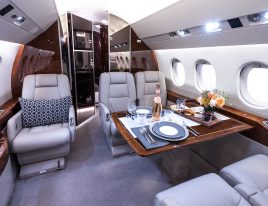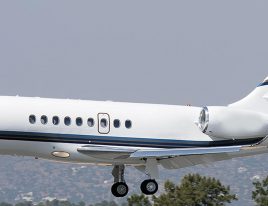Falcon 2000EX - Description
Eight years after the release of the successful Falcon 2000, Dassault released the Falcon 2000EX. It still had all of the components that made the Falcon 2000 great – economy, speed, a large cabin – but improved on all of these elements to make an even better jet.
The cabin of the Dassault Falcon 2000EX has a volume of more than 1,000 cubic feet and usually seats between eight and twelve passengers. A seating arrangement for as many as 19 passengers can be configured, if necessary. In the standard eight-to-twelve seating arrangement, two seats can stretch out flat and combine so that passengers can actually lay down for a nap, just as they would do in a bed. True to the French dedication to style, a wide variety of interior decorating options are available – for example, there are eighteen different metal finishes to choose from just for the bathroom sink alone. 131 cubic feet of baggage space is available, a total of 1,600 pounds.
Two Pratt & Whitney Canada PW308C engines supply the power for the Falcon 2000EX. They provide 7,000 pounds of thrust apiece (1,800 more than the Falcon 2000). At sea level, the Falcon 2000EX can take off in 5,585 feet, but needs 8,120 feet of runway at an altitude of 5,000 feet and a temperature of 77°F. Even though the Falcon 2000EX has a fuel capacity that is 3,800 pounds heavier than the Falcon 2000, it still manages to be just as economical as its predecessor but with a greater range, due largely to the more advanced technology of the Pratt & Whitney Canada engines.
The Falcon 2000EX’s high speed cruise is 482 knots at an altitude of 39,000 feet, and its long range cruise speed is 421 knots at 43,000 feet. It can climb directly to 37,000 feet in sixteen minutes. While carrying six passengers, the Falcon 200EX can fly 4,370 miles (3,850 nautical miles) at .80 Mach – 920 miles further than the Falcon 2000 is able to fly under the same conditions. Its cabin is rated to 8.8 psi, meaning it can maintain a sea level cabin at 25,300 feet.
Another earmark of Dassault’s private jets is that they are easy to maintain. This jet comes with fault monitoring and digital diagnostic systems, which help the mechanic in troubleshooting and repair work. Most parts of the airplane are easy to reach. The Falcon 2000EX was designed to spend as little downtime in the shop as possible. For example, its improved carbon brakes and the addition of a brake monitoring system give the brakes a 25% longer life than that of the Falcon 2000.
The Falcon 2000 was the first private jet that Dassault designed without a physical model. Its design was completely digital, created by Computer Aided Three-dimensional Interactive Application (CATIA) software. This software helped improve aerodynamic structure and simplified the airplane’s systems.
The Falcon 2000EX uses the Collins Pro Line 4 fully integrated avionics suite. It centers on the Honeywell EASy Avionics panel, with four 8 x 10 inch flat panel display screens. The avionics system was designed to be as functional and simple as possible. Systems are grouped by function, and displays screens are close to the functions they control. The system comes standard with an Allied Signal GNS-XES FMS (Flight Management System), a Collins TWR-850 Doppler weather radar, and a dual channel Integrated Avionics Processor System (IAPS).
It is no small feat that the Falcon 2000EX trumped its predecessor. At the time of the 2000’s release, few other private jets could complete trips of 3,450 miles at .80 Mach with eight passengers. For that matter, few jets offered as much passenger comfort as does the Falcon 2000, like seats that can be configured as beds. Dassault turned one of their great successes into an even better achievement with the Falcon 2000EX.








